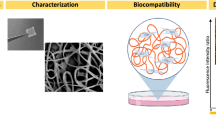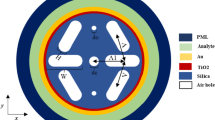Abstract
In this paper, we tested multi-mode optical fibers to select a suitable fiber for effective flow of cell cytometry. In order to align micro nozzle and multi-mode optical fibers, a guide channel was fabricated by silicon wafer etching with MEMS (Micro Electro-Mechanical System) technologies. The fabricated system is advantageous due to its low cost and simplicity in construction. It is possible because multi-mode optical fibers replace many optical lenses and expensive equipment. As a result of the flow cell cytometry using multi-mode optical fibers for both input and output, it is easy to align and we can reduce power consumption. The sensitivity of the micro flow cell cytometry is much better than other cytometries. The output voltage was as high as 300 mV. We injected various cells through the designed and fabricated flow cell cytometry, and we were able to detect cells. Every cell has its own cellulose and wall which cause different light permeability; therefore, we could get different voltage characteristics according to different cells. From the experimental results, we were able to count the number of cells and differentiate the relative size of the injected cells; therefore, we can use the micro flow cell cytometry for analyzing cells [1, 2].
Similar content being viewed by others
References
M. D. Howard M. Shapiro, “Practical Flow Cytometry,” 3rd ed. (1995).
Zbigniew Darzynkiewicz, J. Paul Robinson and Harry A. Crissman, “Flow Cytometry,” 2nd ed. (1995) Part A, B.
Eric Altendorf, Diane Zebert, Mark Holl and Paul Yager, “Differential Blood Cell Counts Obtained Using a Microchannel Based Flow Cytometry” (Transducers, 1997) p. 531.
Kijin Kwon, Minsoo Kim and Sekwang Park, “Sensing System for Flowing Cell Using Optical Method” (Trans. KIEE, 1996) Vol. 45, No. 10, p. 1500.
W. H. Baumann, M. Lehmann, A. Schwinde, R. Ehret, M. Brischwein and B. Wolf, “Microelectronic Sensor System for Microphysiological Application on Living Cells” (Sensors and Actuators B, 1999) Vol. 55, p. 175.
S. Hediger, A. Sayah and M. A. M. Gigs, “A Flow Injection Flow Cytometry System for On-Line Monitoring of Bioreactors” (Biotechnology and Bioengineering, 1999) No. 5, Vol. 62, p. 609.
James F. Leary, Scott R. McLaughlin, Lisa N. Reece, Judahi. Rosenblatt and James A. Hokanson, “Real-time Multivariate Statistical Classification of Cells for Flow Cytometry and Cell Sorting: A Data Mining Application for Stem Cell Isolation and Tumor Purging” (Part of the SPIE Conference on Advanced Techniques in Analytical Cytology, 1999) Vol. 3604, p. 158.
Jiang Jian, Cui Lili, Song Chengrong and Xia Zhongfu, “A Study of the Effect of PTFE Electret on Fibroblast Cell Cycle with Flow Cytometry (FCM)” in Proceedings of the 10th International Symposium on Electrets, 1999, p. 171.
Author information
Authors and Affiliations
Rights and permissions
About this article
Cite this article
Byun, I., Kim, W. & Park, S. A micro flow cell cytometry based on MEMS technologies using silicon and optical fibers. Journal of Materials Science 38, 4603–4605 (2003). https://doi.org/10.1023/A:1027306323657
Issue Date:
DOI: https://doi.org/10.1023/A:1027306323657




